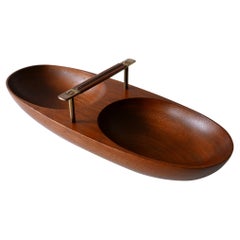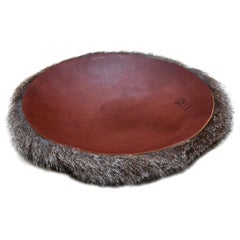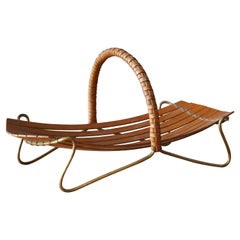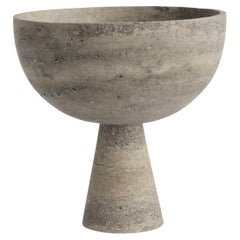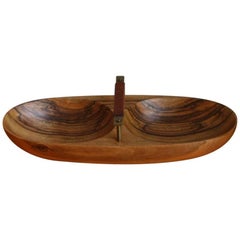Leather Serving Bowls
8
2
to
5
1
10
10
10
2
2
8
2
2
35,183
844
744
501
356
8
8
2
1
1
8
1
Material: Leather
Exceptional Mid-Century Modern Teak Nut Bowl by Carl Auböck Austria 1950s
Located in Munich, DE
Extremely rare and elegant Mid-Century Modern nut bowl by Carl Auböck II, Vienna, Austria, 1950s.
Executed in solid teak wood and brass handle upholstered in leather.
Dimension...
Category
1950s Austrian Mid-Century Modern Vintage Leather Serving Bowls
Materials
Brass
Hairy Wild Man from Botany Bay Bowl Black by Trent Jansen
By Trent Jansen
Located in Beverly Hills, CA
Broached Monsters by Trent Jansen
The vast majority of mainstream Australian mythology commonly used as a
foundation for Australian identity is culturally exclusive. Both Indigenou...
Category
21st Century and Contemporary Australian Leather Serving Bowls
Materials
Aluminum
Pankalangu Bowl
By Trent Jansen
Located in Beverly Hills, CA
Broached monsters by Trent Jansen
The vast majority of mainstream Australian mythology commonly used as a
foundation for Australian identity is culturally exclusive. Both Indigenou...
Category
21st Century and Contemporary Australian Leather Serving Bowls
Materials
Aluminum
Danish Designer, Serving Tray, Brass, Wood, Leather, Cord, Denmark, 1950s
Located in High Point, NC
A modernist serving tray. Designed and produced in Denmark, c. 1950s.
Category
1950s Danish Mid-Century Modern Vintage Leather Serving Bowls
Materials
Brass
Pankalangu Bowl
By Trent Jansen
Located in Beverly Hills, CA
Broached monsters by Trent Jansen
The vast majority of mainstream Australian mythology commonly used as a
foundation for Australian identity is culturally exclusive. Both Indigenous myths, including post-colonial myths and precolonial dreaming stories, and non-indigenous Australian myths, including the bush legend, ANZAC tradition and convict legend, focus on the historical role that the race of authorship has played in building the nation. However, a contemporary understanding of Australian history acknowledges the contribution of both Indigenous and non-indigenous Australians in forging the nation, and the national identity which accompanies it. Instead of perpetuating the same exclusive national myths, perhaps Australians should adopt a national mythology that acknowledges this inclusive understanding of Australian history, a mythology that unites Australians of many backgrounds under a shared Australian identity.
In his book on Australia’s Folklore of Fear, Robert Holden explores pre-colonial ideas of Australia as a Great Southern Land – an imaginary landmass conjured up to counterbalance the continents in the northern hemisphere, as far removed as possible from Britain, the center of the Christian world (Holden, 2001). Holden speaks of Australia as an imaginary world, occupied by unimaginable creatures and monsters.
Holden is commenting in part on the mythical creatures that originated in both British and Aboriginal Australian folklore and were shared by the Aboriginal and non-Aboriginal inhabitants of Sydney during the early years of colonisation. Stories of the yahoo, a creature that resembled a slender man, with long white straight hair, extraordinarily long arms and great talons (Unknown 1842), captured the imaginations of the new British settlers, and soon a fear of the yahoo became a common ground between Aboriginal people and British settlers. is fear of a gruesome and vicious creature gained its potency from the folkloric tales that were used to substantiate its existence. These tales were suitably vague, their lack of detail
attributed to the fierce nature of these creatures and the assumption that no one had survived an encounter (Holden, Thomas et al. 2001).
The yahoo “became one of the very few Aboriginal legends to be embraced by the Europeans” (Holden, Thomas et al. 2001, p16), providing a catalyst for conversation between individuals from these two culturally disparate societies and forming some personal links between these communities. Could creature myths like the yahoo once again form the foundation of a united national...
Category
21st Century and Contemporary Australian Leather Serving Bowls
Materials
Aluminum
Hairy Wild Man from Botany Bay Bowl Grey by Trent Jansen
By Trent Jansen
Located in Beverly Hills, CA
Broached monsters by Trent Jansen
The vast majority of mainstream Australian mythology commonly used as a
foundation for Australian identity is culturally exclusive. Both Indigenous myths, including post-colonial myths and precolonial dreaming stories, and non-indigenous Australian myths, including the bush legend, ANZAC tradition and convict legend, focus on the historical role that the race of authorship has played in building the nation. However, a contemporary understanding of Australian history...
Category
21st Century and Contemporary Australian Leather Serving Bowls
Materials
Aluminum
Hairy Wild Man from Botany Bay Bowl White by Trent Jansen
By Trent Jansen
Located in Beverly Hills, CA
Broached Monsters by Trent Jansen
The vast majority of mainstream Australian mythology commonly used as a
foundation for Australian identity is culturally exclusive. Both Indigenous myths, including post-colonial myths and precolonial dreaming stories, and non-indigenous Australian myths, including the bush legend, ANZAC tradition and convict legend, focus on the historical role that the race of authorship has played in building the nation. However, a contemporary understanding of Australian history...
Category
21st Century and Contemporary Australian Leather Serving Bowls
Materials
Aluminum
Hairy Wild Man from Botany Bay Bowl Grey by Trent Jansen
By Trent Jansen
Located in Beverly Hills, CA
Broached monsters by Trent Jansen
The vast majority of mainstream Australian mythology commonly used as a
foundation for Australian identity is culturally exclusive. Both Indigenous myths, including post-colonial myths and precolonial dreaming stories, and non-indigenous Australian myths, including the bush legend, ANZAC tradition and convict legend, focus on the historical role that the race of authorship has played in building the nation. However, a contemporary understanding of Australian history acknowledges the contribution of both Indigenous and non-indigenous Australians in forging the nation, and the national identity which accompanies it. Instead of perpetuating the same exclusive national myths, perhaps Australians should adopt a national mythology that acknowledges this inclusive understanding of Australian history, a mythology that unites Australians of many backgrounds under a shared Australian identity.
In his book on Australia’s Folklore of Fear, Robert Holden explores pre-colonial ideas of Australia as a Great Southern Land – an imaginary landmass conjured up to counterbalance the continents in the northern hemisphere, as far removed as possible from Britain, the center of the Christian world (Holden, 2001). Holden speaks of Australia as an imaginary world, occupied by unimaginable creatures and monsters.
Holden is commenting in part on the mythical creatures that originated in both British and Aboriginal Australian folklore and were shared by the Aboriginal and non-Aboriginal inhabitants of Sydney during the early years of colonisation. Stories of the yahoo, a creature that resembled a slender man, with long white straight hair, extraordinarily long arms and great talons (Unknown 1842), captured the imaginations of the new British settlers, and soon a fear of the yahoo became a common ground between Aboriginal people and British settlers. is fear of a gruesome and vicious creature gained its potency from the folkloric tales that were used to substantiate its existence. These tales were suitably vague, their lack of detail
attributed to the fierce nature of these creatures and the assumption that no one had survived an encounter (Holden, Thomas et al. 2001).
The yahoo “became one of the very few Aboriginal legends to be embraced by the Europeans” (Holden, Thomas et al. 2001, p16), providing a catalyst for conversation between individuals from these two culturally disparate societies and forming some personal links between these communities. Could creature myths like the yahoo once again form the foundation of a united national...
Category
21st Century and Contemporary Australian Leather Serving Bowls
Materials
Aluminum
Hairy Wild Man from Botany Bay Bowl White by Trent Jansen
By Trent Jansen
Located in Beverly Hills, CA
Broached Monsters by Trent Jansen
The vast majority of mainstream Australian mythology commonly used as a
foundation for Australian identity is culturally exclusive. Both Indigenou...
Category
21st Century and Contemporary Australian Leather Serving Bowls
Materials
Aluminum
Hairy Wild Man from Botany Bay Bowl Black by Trent Jansen
By Trent Jansen
Located in Beverly Hills, CA
Broached Monsters by Trent Jansen
The vast majority of mainstream Australian mythology commonly used as a
foundation for Australian identity is culturally exclusive. Both Indigenous myths, including post-colonial myths and precolonial dreaming stories, and non-indigenous Australian myths, including the bush legend, ANZAC tradition and convict legend, focus on the historical role that the race of authorship has played in building the nation. However, a contemporary understanding of Australian history acknowledges the contribution of both Indigenous and non-indigenous Australians in forging the nation, and the national identity which accompanies it. Instead of perpetuating the same exclusive national myths, perhaps Australians should adopt a national mythology that acknowledges this inclusive understanding of Australian history, a mythology that unites Australians of many backgrounds under a shared Australian identity.
In his book on Australia’s Folklore of Fear, Robert Holden explores pre-colonial ideas of Australia as a Great Southern Land – an imaginary landmass conjured up to counterbalance the continents in the northern hemisphere, as far removed as possible from Britain, the center of the Christian world (Holden, 2001). Holden speaks of Australia as an imaginary world, occupied by unimaginable creatures and monsters.
Holden is commenting in part on the mythical creatures that originated in both British and Aboriginal Australian folklore and were shared by the Aboriginal and non-Aboriginal inhabitants of Sydney during the early years of colonization. Stories of the yahoo, a creature that resembled a slender man, with long white straight hair, extraordinarily long arms and great talons (Unknown 1842), captured the imaginations of the new British settlers, and soon a fear of the yahoo became a common ground between Aboriginal people and British settlers. is fear of a gruesome and vicious creature gained its potency from the folkloric tales that were used to substantiate its existence. These tales were suitably vague, their lack of detail
attributed to the fierce nature of these creatures and the assumption that no one had survived an encounter (Holden, Thomas et al. 2001).
The yahoo “became one of the very few Aboriginal legends to be embraced by the Europeans” (Holden, Thomas et al. 2001, p16), providing a catalyst for conversation between individuals from these two culturally disparate societies and forming some personal links between these communities. Could creature myths like the yahoo once again form the foundation of a united national...
Category
21st Century and Contemporary Australian Leather Serving Bowls
Materials
Aluminum
Related Items
Travertine Eclipse Bowl
Located in EINDHOVEN, NB
Stunning, aesthetic, timeless are words that can be used to describe this elegant and modern travertine Eclipse bowl from Kiwano. Expertly crafted and finished by hand, our travertin...
Category
2010s Dutch Modern Leather Serving Bowls
Materials
Travertine
Silver Travertine Bowl XL
Located in EINDHOVEN, NB
A substantial silver travertine bowl with unique structure rests atop a pedestal for a grand presentation of fruits and vegetables.
Due to the nature of the material, each piece ...
Category
2010s Dutch Modern Leather Serving Bowls
Materials
Travertine
Silver Travertine Narrow Bowl
Located in EINDHOVEN, NB
Stunning, aesthetic, timeless are words that can be used to describe this elegant and modern travertine bowl from Kiwano. Expertly crafted and finished by hand, our travertine bowls ...
Category
2010s Dutch Modern Leather Serving Bowls
Materials
Travertine
Travertine Narrow Bowl
Located in EINDHOVEN, NB
Stunning, aesthetic, timeless are words that can be used to describe this elegant and modern travertine bowl from Kiwano. Expertly crafted and finished by hand, our travertine bowls ...
Category
2010s Dutch Modern Leather Serving Bowls
Materials
Travertine
Mid-Century Modern Carved Teak Wood Bowl
Located in New York, NY
Mid-Century Modern oversized bowl in carved teak wood, with label on the bottom. Measures: 8" height x 15" diameter.
Category
Mid-20th Century Thai Mid-Century Modern Leather Serving Bowls
Materials
Wood
Pink Marble Narrow Bowl
Located in EINDHOVEN, NB
Stunning, aesthetic, timeless are words that can be used to describe this elegant and modern pink marble narrow bowl from Kiwano. Expertly crafted and finished by hand, our traverti...
Category
2010s Dutch Modern Leather Serving Bowls
Materials
Travertine
Travertine Bowl With Lid
Located in EINDHOVEN, NB
Stunning, aesthetic, timeless are words that can be used to describe this elegant and modern travertine bowl from Kiwano. Expertly crafted and finished by hand, our travertine vases ...
Category
2010s Dutch Modern Leather Serving Bowls
Materials
Marble
Carl Auböck Nut Teak Bowls
Located in Munich, DE
Original 1950s bowl element made of solid teak wood and and two solid brass handles on the sides. This fantastic piece was designed by Carl Auböck in the 1950s, and handcrafted in hi...
Category
1950s Austrian Mid-Century Modern Vintage Leather Serving Bowls
Materials
Brass
Danish Mid-Century Modern Solid Teak Bowl
Located in Albano Laziale, Rome/Lazio
Danish Modern handmade teak bowl in good used condition. This is a well made bowl and very light and finely turned.
Category
Mid-20th Century Italian Mid-Century Modern Leather Serving Bowls
Materials
Hardwood
Large Danish Teak Bowl by Richard Nissen
By Richard Nissen, Nissen
Located in Fort Lauderdale, FL
Large vintage danish teak bowl by Nissen.
Designer: Richard Nissen
Manufacturer: Nissen Studios
Year: 1960s
Origin: Denmark
Dimensions: 5" tall x 11" diameter.
Category
Mid-20th Century Danish Mid-Century Modern Leather Serving Bowls
Materials
Teak
Danish Glass Salad Serving Bowl on Curved Teak Wood Stand
Located in New York, NY
1960's Danish Modern opaque pressed glass bowl with curved teak wood stand. Glass bowl measures 10" diameter x 4.25" height without stand.
Category
Mid-20th Century Danish Scandinavian Modern Leather Serving Bowls
Materials
Teak
Vintage Mexican Terracotta Bowl
Located in Chicago, IL
A beautiful vintage Mexican terracotta bowl with two handles, a ruffled lip, two large drip glazed splotches inside. The exterior is unglazed. Perfect f...
Category
20th Century Mexican Rustic Leather Serving Bowls
Materials
Terracotta
Previously Available Items
Exceptional Mid-Century Modern Teak Nut Bowl by Carl Auböck, 1950s, Austria
Located in Munich, DE
Extremely rare and elegant Mid-Century Modern nut bowl by Carl Auböck II, Vienna, Austria, 1950s.
Executed in solid teak wood and brass handle upholstered in leather.
Dimensions:...
Category
1950s Austrian Mid-Century Modern Vintage Leather Serving Bowls
Materials
Brass
H 3.94 in W 15.75 in D 6.11 in
Carl Auböck Nut Bowl #2
Located in London, GB
Vintage nut bowl carved out of solid walnut by Carl Auböck II, Vienna, circa 1950.
The bowl bears the Auböck stamp underneath and has a brass handle upholste...
Category
1950s Austrian Modern Vintage Leather Serving Bowls
Materials
Brass
Double Bowl by Carl Auböck
Located in London, GB
Great double serving bowl by Carl Auböck in carved Walnut , brass and leather.
Category
1950s Austrian Modern Vintage Leather Serving Bowls
Materials
Brass
Fantastic Wallnut Bowl by Carl Auböck
Located in London, GB
Double bowl with a brass and leather handle . Beautiful grain and patina to the wood.
Category
1950s Austrian Modern Vintage Leather Serving Bowls
Materials
Brass
Carl Aubock Fruitbowl
Located in London, GB
Nutwood Double bowl by Carl Aubock. Sculptural bowl with a brass handle covered in leather.
Category
20th Century Austrian Leather Serving Bowls
Materials
Brass
Yemen/Saudi Border Wooden Bowl - Collection of four
Located in Chicago, IL
Handsome collection of 4 bowls.
Household bowls used for cooking and kitchen tasks /small woven leather tassels and repairs – very special not your typical wooden bowls! 20th...
Household bowls used for cooking and kitchen tasks /small woven leather tassels and repairs – very special not your typical wooden bowls! 20th...
Category
20th Century Leather Serving Bowls
Materials
Metal
Recently Viewed
View AllMore Ways To Browse
Pyrex Vintage Bowls
Danish Oval Teak Bowl
Jadeite Bowl
Holmgaard Bowl
Antique Copper Mixing Bowl
Seletti Bowl
Vintage Wooden Salad Bowls
Herbert Krenchel On Sale
Holmgaard Bowls
Arthur Court Clam
Tiffany Camille Glass
Seashell Serving Bowls
Cafe Au Lait Bowls
Oneida Silver Tray
Oneida Tray
Jadeite Bowls Vintage
Cantaloupe Bowls
Cauliflower Bowl
